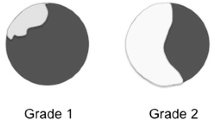Abstract
This is a case of an 11½-year-old diagnosed with Kawasaki disease at 6 months of age. Distal left main coronary aneurysm involving the proximal anterior descending and circumflex had progressed into a chronic total occlusion. We report the first application of a novel percutaneous technique using the CROSSER catheter system in a child. The CROSSER is a high-frequency mechanical vibration catheter-based technology developed to safely penetrate through calcific and noncalcific coronary artery occlusions. This is also the first Kawasaki disease patient to benefit from this technology; in this disease, coronary artery stenosis is typically associated with heavy calcification.




Similar content being viewed by others
References
Akaji T, Ogawa S, Ino T, et al. (2000) Catheter interventional treatment in Kawasaki disease: a report from the Japanese Pediatric Interventional Cardiology Investigation Group. J Pediatr 137:181–186
Buellesfeld L, Gerckens U, Mueller R, Schmidt T, Grube E (2005) Polymer-based paclitaxel-eluting stent for treatment of chronic total occlusions of native coronaries: results of a Taxus CTO registry. Catheter Cardiovasc Interv 66:173–177
Colombo A, Drzewiecki J, Banning A, et al. TAXUS II Study Group (2003) Randomized study to assess the effectiveness of slow- and moderate-release polymer-based paclitaxel eluting stents for coronary artery lesion. Circulation 108:788–794
Grube E, Sütsch G, Lim VY, et al. (2006) High-frequency mechanical vibration to recanalize chronic total occlusions after failure to cross with conventional guidewires. J Invasive Cardiol 18:85–91
Ishii M, Ueno T, Akagi T, et al. (2001) Research Committee of Ministry of Health, Labour and Welfare—“Study of treatment and long-term management in Kawasaki disease.” Guidelines for catheter intervention in coronary artery lesion in Kawasaki disease. Pediatr Int 43: 558–562
Ishii M, Ueno T, Ikeda H, et al. (2002) Sequential follow-up results of catheter intervention for coronary artery lesions after Kawasaki disease: quantitative coronary artery angiography and intravascular ultrasound imaging study. Circulation 105:3004–3010
Kato H, Sugimura T, Akagi T, et al. (1996) Long-term consequences of Kawasaki disease. A 10- to 21-year follow-up study of 594 patients. Circulation 94:1379–1385
Kitamura S (2004) Advances in Kawasaki disease bypass surgery for coronary artery obstructions. Prog Pediatr Cardiol 19:167–177
Lapierre C, Dahdah NS, Guerin R, Fournier A, Miró J, Duret J-S (2002) Significance of coronary artery calcification in Kawasaki disease. 88th annual meeting, Radiology Society of North America, Chicago, IL, USA, December 2002. Radiology Suppl 225:134
Li SS, Cheng BC, Lee SH (2005) Giant coronary aneurysm formation after sirolimus-eluting stent implantation in Kawasaki disease. Circulation 112:e105–e107
Melzi G, Cosgrave J, Biondi-Zoccai GL, et al. (2006) A novel approach to chronic total occlusions: the CROSSER system. Catheter Cardiovasc Interv 68:29–35
Migliorini A, Moschi G, Vergara R, et al. (2006) Drug-eluting stent-supported percutaneous coronary intervention for chronic total coronary occlusion. Catheter Cardiovasc Interv 67:344–348
Morice MC, Serruys PW, Sousa JE, et al. (2002) RAVEL Study Group. A randomized comparison of a sirolimus eluting stent with a standard stent for coronary revascularization. N Engl J Med 346:1773–1780
Newburger JW, Takahashi M, Gerber MA, et al. (2004) Diagnosis, treatment, and long-term management of Kawasaki disease. A statement for health professionals from the Committee on Rheumatic Fever, Endocarditis and Kawasaki Disease, Council on Cardiovascular Disease in the Young, American Heart Association Endorsed by the American Academy of Pediatrics. Circulation 10:2747–2771
Tanaka N, Naoe S, Masuda H, Veno T (1986) Pathological study of sequelae of Kawasaki disease MCLS: with special reference to the heart and coronary arterial lesions. Acta Pathol Jpn 36:1513–1527
Tsuda E, Kamiya T, Ono Y, et al. (2005) Incidence of stenotic lesions predicted by acute changes in coronary arterial diameter during Kawasaki disease. Pediatr Cardiol 26:73–79
Tsuda E, Kitamura S, and the Cooperative Study Group of Japan (2004) National survey of coronary artery bypass grafting for coronary stenosis caused by Kawasaki disease in Japan. Circulation 110(Suppl 1):II61–II66
Author information
Authors and Affiliations
Corresponding author
Rights and permissions
About this article
Cite this article
Dahdah, N., Ibrahim, R. & Cannon, L. First Recanalization of a Coronary Artery Chronic Total Obstruction in an 11-Year-Old Child with Kawasaki Disease Sequelae Using the CROSSER Catheter. Pediatr Cardiol 28, 389–393 (2007). https://doi.org/10.1007/s00246-006-0083-3
Received:
Accepted:
Published:
Issue Date:
DOI: https://doi.org/10.1007/s00246-006-0083-3




